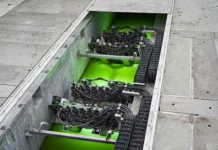IUVA Healthcare/UV Working Group
Troy Cowan IUVA Healthcare/UV Working Group facilitator
In preparation for a new series of webinars on our standards initiative, we reached out to EPA’s Office of Chemical Safety and Pollution Prevention and the EPA’s Smart Sectors Program Office. Our objective was to lay groundwork for EPA’s participation, something sorely missed in our “Enhancing the New Normalcy with UV Disinfection” program of last April (links on IUVA’s home page, https://iuva.org). We had a very fruitful discussion, and we hope it will lead to new collaborative initiatives in useful and usable UV-C disinfection regulations, standards and guidance. Many thanks to these two offices for opening this new dialogue.
Our discussion included recent enforcement actions; specifically regarding labeling requirements and what constitutes “false or misleading statements” in labeling or marketing media. EPA provided three resource references:
- A Federal Register Notice, published in November 1976, detailing EPA’s Policy Statement and providing a “consolidation and clarification of all such requirements” applicable to pest control devices and device producers under the Federal Insecticide, Fungicide and Rodenticide Act (FIFRA)1
- A letter from the National Electrical Manufacturers Association (NEMA) in December of 2020, requesting guidance on the acceptability of using generic statements of UV-C device performance and efficacy2
- EPA’s April 2021 response, in which EPA essentially rejects all generic claims as “false or misleading” “unless they are appropriately qualified on labeling and supported by the product specific testing.” EPA also maintains that generic claims that a device “is safe” also may be “false or misleading” due to a variety of factors that impact safety, including “user directions that prevent public health risks – such as electric shock or UV exposure (e.g., to skin or eyes) – and device design, among other factors.” EPA further cautions that “Selling or distributing pesticidal devices with false or misleading claims about their safety or efficacy may subject the seller or distributor to enforcement action and penalties under FIFRA.”3
In the 40-plus years this author has dealt with federal regulations, it is rare that they are that firm in their interpretation or application, especially when covering items like “pesticide devices,” which aren’t registered or controlled (re: 40 CFR 152.500(b).4 So, we went digging. First, we researched FIFRA itself5, and then the EPA regulations (40 CFR 150 series). Here’s what we found.
Point 1: The devices may not be regulated, but their marketing and branding are!
This is done by making it unlawful to sell a misbranded device [Section 12(a)(1)(F)]. As defined, a device is “misbranded” [per FIFRA Section 2(q)(1)] if:
- (A) “its labeling bears any statement, design or graphic representation … is false or misleading in any particular;” (FIFRA Section 2 Definitions, Item 2.q) or if
- (F) “the labeling accompanying it does not contain directions for use which are necessary … to protect health and the environment;” or if
- (G) “the label does not contain a warning or caution statement … adequate to protect health and the environment…”
Point 2: Can EPA really do that, even if the devices aren’t regulated, per se?
Yep … In accordance with FIFRA Sect. 25.c: “The Administrator, after notice and opportunity for hearing, is authorized Item (4) “to specify those classes of devices which shall be subject to any provision of paragraph 2(q)(1)…” And the EPA administrator has done that in 40 CFR 156.10(a)(5). In that reg., EPA specifies that any device called out in 40 CFR 152.500 is subject to the misbranding provisions. So, in general, if a device (other than firearms) destroys or mitigates any pest, plant or animal life (other than those on a human or animal), it’s covered by misbranding requirements.
Point 3: So, what makes a label ‘misbranding’?
It includes statements deemed to be “false or misleading” dealing with the following:
- effectiveness [item (ii)]
- comparisons to other devices [item (iv)]
- endorsements or recommendations by federal agencies [item (v)]
- true statements used to give a false or misleading impression [item (vii)]
- disclaimers that detract from required labeling [item (viii)] (See 40 CFR 156.10(a)(5).)
Examples of commonly used but unacceptable efficacy claims can be found in EPA’s Label Review Manual, Chapter 12, Section VII, “Efficacy Related Claims.”6 Essentially, if a manufacturer is making claims about a device, the manufacturer should have scientific data to support the claims, with the reference cited in the labeling.
Point 4: This just covers labels … but doesn’t apply to advertising, right?
Sorry, but wrong. EPA applies the provisions of FIFRA Section 12(a)(1)(B), to advertising as well, saying it is unlawful to make any claims during distribution or sale (i.e., advertising) that substantially differ from claims made for it as a part of the statement required (i.e., labeling).
Point 5: Surprise! Violations are a big deal.
FIFRA Section 13 provides for “Stop Sale, Use or Removal Orders,” as well as “Seizures” and “Disposal” of devices when violations are found. As for consequences, FIFRA Section 14 describes the possible Civil and Criminal Penalties, from fines up to possible prison terms. Not fun to contemplate.
Why the big emphasis on labeling requirements?
- EPA is enforcing FIFRA more, as documented in the NEMA letter. If the regulator takes it seriously, so should we.
- More UV-C product and advertising is making it into the public domain, increasing the visibility of “false and misleading claims” from less-than-scrupulous suppliers and discrediting our industry.
You need examples?
- A UV-C handheld, battery-powered unit advertised on Amazon claiming 7-log10 efficacy? (An impossible claim to meet, much less test for).
- A UV-C ad that talks about “killing” pathogens? (UV-C only inactivates pathogens.)
- UV-C sterilizer with the claim it kills 99.99% of germs? (Beyond the “kill” vs “inactivate” issue, “sterilizers” must hit 6 log10.)
Bottom Line
With all the recent advances in UV-C disinfection technologies, it may be time to review where we are, internally, to make sure our labeling “house” is in order, in anticipation of this increased scrutiny. The new LED products using nontraditional germicidal wavelengths espousing increased efficacies, the new Far UV-C 222nm technologies with their new safety claims, the renewed focus on various ways to safely deliver upper room UV-C to combat SARS-CoV-2 – all could benefit from meticulous adherence to labeling and advertising compliance with FIFRA norms going forward to keep us out of EPA trouble.
What’s IUVA doing to help improve this situation? We’re working hard to put new tools into the hands of IUVA members and the UV-C community to improve the credibility and scientific standing of UV-C efficacy and safety studies, including the following:
- We’re working on UV-C ANSI-acceptable standards for measuring the UV-C emitter output for specified wavelengths-of-interest in an auditable and reproducible manner (e.g., ANSI/IES/IUVA/LM-92 is the first of several such standards, soon to be published for public comment).
- The seminal work of Drs. Mahsa Masjoudi, Madjid Mohseni and James Bolton on the “Sensitivity of Bacteria, Protozoa, Viruses and Other Microorganisms to Ultraviolet Radiation,” undoubtedly the largest compilation of UV fluence (dosage) data ever assembled, published in late August in the Journal of Research of NIST, a peer-reviewed and Pub-Med indexed journal, making this data set uniquely citable as the national reference for fluence curves across the UV-C industry.
- We continue to develop new webinars, new articles and new ways to outreach via the media and the consumer public, conveying credible, science-based, unbiased information about how UV-C can and should be applied for the improved health of the nation.
Your feedback is invited and always appreciated. Many thanks for your continued support and advocacy. And remember, as always … it’s all about saving lives.
The IUVA Healthcare/UV Working Group endeavors to promote the acceptance of UV disinfecting technologies as a credible, valued part of environmental management throughout the healthcare industry. In this column, the UV community will be updated on these efforts and the latest information on UV technology as it pertains to the healthcare industry.
Contact: Troy Cowan, [email protected]
References
- https://www.epa.gov/sites/default/files/2015-06/documents/frn-devices.pdf
- https://www.epa.gov/sites/default/files/2021-05/documents/nema-letter-to-epa-uv-lighting-fifra.pdf
- https://www.epa.gov/sites/default/files/2021-05/documents/nema-response_4-12-2021.pdf
- https://www.ecfr.gov/cgi-bin/text-idxnode=pt40.26.152&rgn=div5#se40.26.152_1500)
- https://www.agriculture.senate.gov/imo/media/doc/FIFRA.pdf
- https://www.epa.gov/sites/default/files/2017-10/documents/chap-12-nov-2013.pdf, section 12-6





